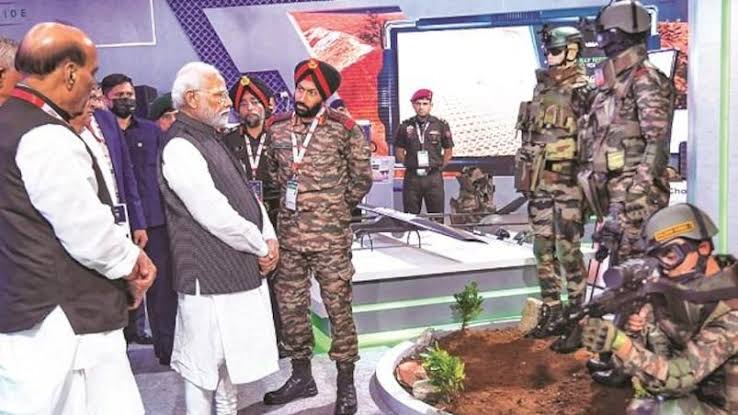Make in India : Can reverse Defence import/indigenous ratio in five years
(Author’s Note: An old article first published in jagrukbharat.com in November 2015 and just in two days had over 35000 clicks.)

The clarion call by our PM Modi to ‘Make in India’ has resonance with those Indian hearts and minds who dream for the country. It will certainly be vital for our industrial output, employment and savings in the outflow of foreign exchange and thus raising the National Wealth.
In line with the above initiative, now our Raksha Mantri, Shri Manohar Parrikar has asserted that he can reverse defence import/indigenous ratio in next five years. Can he? Yes, certainly he can! And to back my faith, here is an anecdote from long time back, fully in line with the theme of Make in India.)
Sometime in the early 1990s, a military establishment was raised to upgrade our Para Cdos into SF. This small fledgling establishment among other things had a section with the high-sounding name of Research & Development. As the raising progressed, there were visitors from Majors to Major Generals, and most of them were curious about this R&D Section. Often there used to be a comment—lightest of which used to be a joke—but mostly full of snide or acidic comments. As no Commander was posted till the raising was nearly completed in ten months, the burden of suffering such naysayers fell on the General Staff Officer, myself a Major with about 15 years’ service, who was in charge of the raising (those days you became a Lt Col, if selected, after about 17 years of service).
Fed up of the taunts, the Major tried to think of a plan. The Staff Capt Sanjiv Tyagi gave a beautiful idea and a plan was made ready but there were no resources.

Col Sanjiv Tyagi, then Staff Capt at HQ SF( 93′ to ‘95)
A few months down the line when the Commander of the outfit, Brigadier S S Mann, VSM, arrived, the plan was immediately put up to him by the Major, right after the initial Briefings. The aim was to have a device fabricated by the R&D Section, which would be useful to the SF and at the same time have a grand impact on the ‘Doubting Thomases’. The device chosen was the obsolete Exploder Dynamo Star, Mark 7 and its Test Set Demolition—both weighing together about 17 Kg plus—available with the Indian Military since Second World War. This weight had to be physically carried by the Para Cdos on their backs at the Section level and above. In comparison, as the Cdos had seen in Sri Lanka, the LTTE had sleek looking devices, weighing less than a Kg, and virtually fail safe.
The Plan was approved and the Major called the young technical officers who, by now had reported, and briefed them to fabricate the device at the earliest. Meanwhile, both the Army HQ and the DRDO had been approached for a replacement of these two bulky and near obsolete items by a Made In India item or through import (though a fledgling HQ, we were permitted to interact directly with DRDO). Army HQ, Military Operations was also asked to issue funds for the R&D Section. Two months later the result was as under:
(a) Army HQ forwarded a set of brochures from US/NATO countries. Cost of required device were between 5 to 10 thousand American Dollars each.
(b) DRDO said that a prototype could be developed within six months to a year, with the cost somewhere between 50 thousand to 80 thousand Rupees each.
(c) The R&D Section produced a sleek looking lightweight device weighing just 300gm for a princely sum of Rupees 800. The designing was done by a young officer from Corps of Signals, a young officer from Corps of Engineers and a young officer from Corps of EME. The manufacturing was done with the help of a local radio mechanic who was paid a grand sum of Rupees 500 for his effort. To make the item soldier-proof, the weight was increased to 600gm by strengthening the outer frame.

Capt G P Chamoli (now Brig) from Corps of Signals. He was made to undergo the entire probation tests and he cleared them all. So he was sent for Para Jumps also and given the Maroon Berret
Luckily, the DGMO (Director General Military Operations) was also visiting just then and was shown the device. A quick demonstration was also given by exploding a very small amount of plastic explosive, just a few meters away from the DGMO.
This resulted in immediate grant of Rupees 30,000 by the DGMO, to manufacture the first lot to meet the immediate training requirement. Soon rest of the Army, especially Corps of Engineers units, too, started enquiries for the product but the cost to them was placed at Rupees 3000 apiece.
Notably, two of the young technical officers became Brigadiers and one of them G P Chamoli was about to become a Maj Gen and one day was sure to head the Corps of Signals. However in spite of heading his batch till doing the NDC Course , the “great system“ found him unfit to become a Major General …..some thing indeed opaque in the system somewhere.
So, if Make in India could be done with virtually no resources by a bunch of very young technical officers due to initiative of an Infantry Major rank officer, backed by a thinking Brigadier, then certainly it can be achieved by an IITian Raksha Mantri with the backing of the PM and the Nation.



